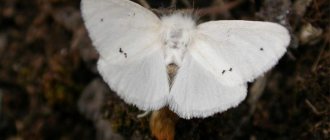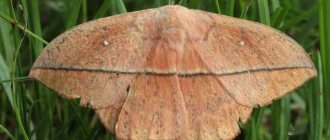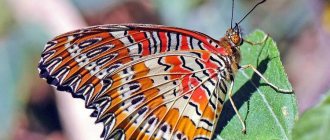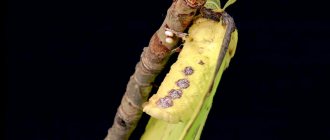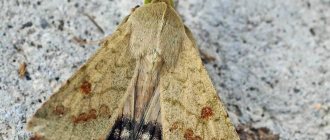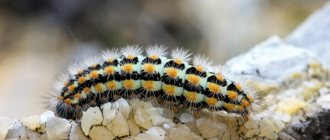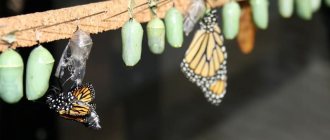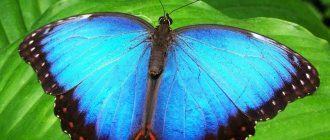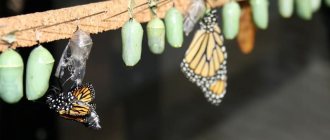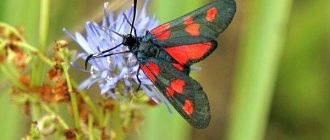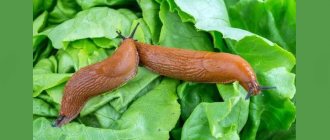One of the greatest natural miracles is the transformation of a fat and clumsy caterpillar into a butterfly. Moreover, the butterfly is not always more beautiful than its larva - some caterpillars are so unusual, brightly colored and have a bizarre shape that the butterfly, especially if it is nocturnal, looks like an ugly duckling next to it.
This review contains magnificent photos illustrating what caterpillars of some species look like and what kind of butterfly they turn into. And also, some interesting facts about these incomparable creatures of nature are presented.
Brahmin Moth
Brahmei butterflies are found in the East - in India, China, Burma, and are also common on some islands of Japan.
This is a nocturnal species of butterfly; they fly at night and sleep during the day with their wings spread. Butterflies and caterpillars are poisonous, so they have no enemies.
Blind Hawkmoth
Hawkmoth caterpillar
The hawkmoth caterpillar is found in central Russia, Siberia, and the Far East. It feeds on the foliage of birch, poplar, and willow. A green caterpillar with a horn on its tail perfectly camouflages itself as a rolled up tree leaf. Diagonal thin stripes on the body of the larva resemble the veins of leaves. This coloring helps the hawk moth hide from its enemies.
Peacock eye cecropia (Hyalophora cecropia)
The caterpillar is very poisonous, so with all its bright color it shows that it is better not to touch it. The tubercles have a rich color and additionally have dots, like those of poisonous ladybugs.
The peacock eye is the largest moth in America - larger than the palm of your hand.
Redtail
Redtail caterpillar
The caterpillar is found in the forest-steppe zone of the entire continent, preferring to eat the leaves of various shrubs. The fluffy caterpillars are covered with brown or gray hairs, and the end of their body is painted in a bright scarlet color, the presence of which gave rise to the name of the insects.
On a note!
Redtails also signal with their bright tails that they are poisonous. When this small five-centimeter caterpillar comes into contact with human skin, an allergic reaction occurs.
Spicebush Swallowtail
At first glance, this creature looks more like a fish or lizard than a caterpillar. Huge false eyes scare away predators. In addition, during its life of a couple of months, the larva changes color - the egg hatches chocolate brown with large white spots, then becomes bright emerald, and before pupation - orange with a red belly.
The black-blue velvet butterfly is common in North America; in some places it gathers in colonies of hundreds of thousands of specimens.
Peacock eye
Peacock Eye Caterpillar
The beautiful nocturnal butterfly caterpillar is known for its large size - some specimens exceed 10 cm in length. The large green caterpillar of the Peacock's eye lives in the western part of Russia, the Caucasus, and Crimea. The main food is fruit trees:
- Apple tree;
- pear;
- Walnut;
- plum;
- cherry.
On a note!
An interesting feature of the peacock eye is the change in color during the development of the larva. Before pupation, the yellow color changes to green. And the pupa itself turns brown.
Black Swallowtail
The caterpillar of the black swallowtail is very bright and noticeable - so that predators do not covet it. Although in fact it is quite edible.
This is undoubtedly one of the most beautiful European butterflies. During the flight, you can see how the color of the wings of the black swallowtail shimmers.
Beautiful caterpillars: name, characteristics, what it looks like, what kind of butterfly it turns out, description, photo
Nature has made even certain types of caterpillars beautiful so that we can admire their uniqueness. Their luxurious hairs and interesting colors delight you and you want to look at such a natural phenomenon without taking your eyes off.
Beautiful caterpillars
Saturnia Io
Saturnia Io (Automeris io) is a beautiful caterpillar with green hairs in the form of pompoms. It is impossible to even imagine that a larva with such a color turns into a red butterfly. She seems to look with her black eyes located on her pink-yellow lower wings.
Blue Morpho Blue Morpho
Blue Morpho - it is impossible to pass by at the sight of such a caterpillar. I want to look at every color stroke on the surface of her body. She is a dream for any artist. Transforms into a small blue butterfly.
Slug
Slug butterfly
Slug worm (Isochaetes beutenmuelleri) - looks like an ornament that is made of blue glass covered in fake snow. The fabulousness of this caterpillar is given by the fibers in the form of needles. They seem to be covered with real frost. The butterfly is a regular brown moth.
Tailed Emperor Butterfly (Polyura Sempronius)
This is not a dinosaur, but a soft imperial caterpillar. Its size is up to 2 cm, and the shell visually enlarges the baby and scares the birds.
The “tailed emperor” is found only in Australia and feeds on nectar from only one plant.
Spiny oak slug caterpillar / Euclea delphinii
Experts note that the larva of this species of butterfly is not too dangerous, but during its evolution it has also developed protective mechanisms. They reach a length of no more than 1.5 cm, and feed, if you look at the species name of the butterfly, on oak leaves.
The body color is quite variegated. Throughout the body there are small outgrowths, at the tips of which a special substance is concentrated. Once in contact with the skin, this mucus causes a rash. These shoots are spiny. Touching them is quite painful. The touch is quite painful.
In addition to oak trees, such lumpy creatures can be found on willows and maples. She loves to eat both the leaves and fruits of garden trees, thereby harming agriculture.
5
Dalcerida (Acraga coa)
The Dalcerida caterpillar appears glassy and transparent.
At the same time, the butterfly itself is very shaggy, brick-colored. Refers to moths. Lives in the tropical forests of Mexico.
Classification
Each butterfly was a caterpillar, and the color of the caterpillar may differ from the color of the butterfly. Most often, caterpillars are herbivorous insects, but predators can also be found in nature. Depending on their food, caterpillars are divided into the following classes:
Polyphages. This type of caterpillar feeds on almost any plant. They represent butterfly species such as wine hawk moth, blind hawk moth, kaya bear, peacock eye and other insects.
Monophages . These caterpillars prefer to eat only specific types of plants, which is where their names come from. Examples of monophages include cabbage moths, apple moths, silkworms and other species.
Oligophages. The food of these insects is limited to one type of plant that belongs to a specific family or type. As a rule, this is a pine butterfly, swallowtail, polyxena.
Xylophagous. The diet of this class is varied with various tree barks. Such caterpillars are leafworms, woodworms, and so on.
Caterpillars also differ in their distribution area. A number of species inhabit the subtropics, and some inhabit the northern regions. Among the large number of caterpillars, there are also quite valuable representatives, for example, silkworms. Silk threads are obtained from their cocoon.
Moth (Acharia Stimulea)
This strange creature of incomprehensible color, with a bright green blanket, is a very dangerous creature. Each shoot secretes poison, and even one touch to the caterpillar can put an adult in the hospital.
And the butterfly is an ordinary night moth, almost invisible.
Poisonous caterpillars: name, characteristics, what it looks like, what kind of butterfly it turns out, description, photo
A person should be wary of poisonous caterpillars. You cannot pick them up or even come close. Many species cause a burning sensation on the skin upon contact with the insect’s body, while others can even be life-threatening: breathing rhythm is disrupted, heart palpitations, headaches, and so on occur.
Poisonous caterpillars
Poison caterpillar butterfly
Flannel Moth - This poisonous caterpillar looks like a small hamster. Her butterfly is no less beautiful. But it is strictly forbidden to touch it with your hands, as it causes an allergic reaction and even a feeling of suffocation.
Lazy clown caterpillar
Lazy clown caterpillar butterfly
The “lazy clown” caterpillar (lat. Lonomia obliqua) lives in Uruguay. A highly poisonous insect that secretes a special natural toxin. The venom of this caterpillar causes skin burns. In addition, the toxin can penetrate through the skin to internal organs and cause hemorrhage, for example, in the gastrointestinal tract, kidneys, and also causes pulmonary edema and disruption of the central nervous system.
Saturnia Mayan caterpillar
Saturnia Maya caterpillar butterfly
Saturnia Maya caterpillar (Hemileuca maia) -
covered with hollow spines, upon contact with which, a burning sensation on the skin, rash and nausea appears.
The appearance of this caterpillar should be frightening, because a crawling, hairy insect with black spines will disgust any person. This caterpillar lives in our latitudes on oaks and willows. The butterfly from this caterpillar is also black in color with a hairy body, but it is not poisonous. Volyanka caterpillar
Orgyia leucostigma
caterpillar butterfly
— you won’t be able to pass by such a caterpillar, since it is noticeable thanks to its red head and white body.
Eats everything green and woody in its path. If you touch the hairs of this insect, burns and irritation immediately occur. The rash may not go away for several weeks. White cedar moth caterpillar
White cedar moth caterpillar butterfly
White cedar moth caterpillar (leptocneria reducta)
- lives on a cedar tree in several groups at the same time, eating every single leaf. Contact with the hairs of this caterpillar causes irritation, but not for all people. If a person has sensitive skin, they will most likely feel a burn and develop a rash.
Remember: Beautiful caterpillars are almost always poisonous. Their bright colors are designed to scare away predators. Therefore, if you see, for example, a blue caterpillar with an orange head or a green caterpillar with bright red, blue or black spots, try not to touch such insects with your hands and move away from them.
Witch moth caterpillar (Phobetron pithecium)
A real caterpillar witch! Lives in orchards of both American continents. It is also called the “slug monkey” for its unusual method of movement - it crawls along one leaf and jumps onto another leaf.
Witch butterflies are also quite spectacular and large. They are nocturnal.
Control of caterpillar pests
There are three groups of ways to combat caterpillars devouring crops of vegetables, fruits and vegetables.
Mechanical method - when caterpillars are collected manually, their overwintering clutches are cut off.
One of the most effective methods is to catch them using adhesive-coated belts or traps filled with bait liquid.
The biological method is when birds are attracted to agricultural fields and orchards and eat caterpillars, arranging feeders and birdhouses for the birds.
Caterpillar snake
The chemical method is the most effective, but after some time the caterpillars get used to the composition of the drugs and stop dying, so the chemical method is alternated with the biological one.
In dacha conditions, to combat the invasion of caterpillars, infusions of herbs are used - black henbane (it works well against the caterpillars of the ubiquitous cabbage butterfly), hemlock (it is effective against caterpillars attacking fruit trees), peppermint, and elderberry.
Greta Oto, or Glass Winged Butterfly
The caterpillar of the incredible Greta butterfly looks ordinary and does not attract attention.
But the glass butterfly with transparent wings looks simply amazing. This species lives in Mexico and throughout South America.
Admiral
Caterpillars of the Admiral butterfly
A large, shaggy black-and-orange butterfly that is widespread throughout Russia. It is a migratory insect species. Arriving in more northern regions, it lays eggs on nettle or hop leaves. The admiral winters in the southern regions.
On a note!
Nettles also live on nettle caterpillars similar to admiral larvae.
A small black caterpillar with yellow stripes on the sides appears in May and within a few days creates a kind of canopy around itself from the leaves of the food plant. Throughout the summer it feeds inside its shelter, remaining hidden from predators. At the end of August, the black caterpillar turns into a pupa.
Large harpy or spotted forktail (Cerura vinula)
Both the caterpillar and the harpy butterfly itself have a rather terrifying appearance. The growth in the form of a mustache confuses the birds, and they do not risk feasting on this completely edible larva.
The white moth from the Corydalis family is quite large and emits an unpleasant odor, so few people would dare try it.
Butterfly larva
The birth of a butterfly is associated with a certain stage of insect development. After an adult has laid eggs in some secluded place, larvae emerge from them in the form of small worms. These worms are quite voracious creatures. They eat a lot of greens in order to move to another stage of development.
These larvae are called caterpillars. An insect can be a caterpillar for either several days or several years, depending on the species. Typically, each type of caterpillar eats a specific type of plant. They often become pests of any crops, fruit trees, berries, vegetables, fruits, etc. After a certain time, the caterpillar turns into a cocoon, which is called a pupa. Then an adult, called a butterfly, emerges from the cocoon.
Interesting to know! The larger the butterflies, the larger the caterpillars and vice versa.
All types of caterpillars may differ in size, development periods, colors, and habitats, but they all have the same body structure. The body structure of a caterpillar consists of:
- From a well-defined head of regular round shape, oral apparatus, visual organs and horn-shaped antennae.
- Breasts.
- Abdominal section.
- Several pairs of limbs.
As a rule, a caterpillar has at least 5-6 pairs of eyes located nearby. The mouth has several small teeth with which they chew plants. There are small hairs or spine-like growths on the body. As a rule, the caterpillar moves quickly along leaves, branches and other surfaces.
Flannel Moth
This is not a tuft of fur on a bush, but the larva of a flannel moth. Very poisonous creature!!! Under no circumstances should you touch it!
Adult flannel moths appear soft and cuddly, but they are also poisonous. Found in the USA and Mexico.
Purple Hawkmoth / Mimas tiliae
The small caterpillar reaches an average length of no more than 6 cm at the peak of development. The species of this inconspicuous butterfly was discovered by Carl Linnaeus in 1758.
The body is rough, and there is a horn on the tail. This horny process has a protective shield. Development begins in early summer. During this period, they can be found on the branches of wild and fruit trees. There are especially many of them on linden, birch, and various types of alder. By the time of pupation, the body color completely changes.
It is not dangerous in itself, but if it crawls across the body, it will leave a bright mark. There are substances on her body that cause an allergic reaction. It is most difficult for allergy sufferers and people with weakened immune systems.
9
Blue Morpho
This strange furry stick, whose head is unclear and where the tail is, after transformation will become one of the most beautiful butterflies in the world.
The blue Morpho butterfly lives in Central and South America. It is very large - reaches 210 mm in span. The wings have a metallic tint and shimmer when flying. There are 60 varieties of Morpho in all shades of blue.
Life cycle
Different types of caterpillars live from several weeks to several years. For example, the larvae of butterflies living in the north do not have time to develop during the short summer season; they hibernate until the next one - the horned butterfly, whose habitat is the Arctic, exists as a caterpillar for an average of 13 years.
During the life cycle, amazing metamorphoses occur with caterpillars - from an increase in size and a change in color to the transformation from an individual with bare skin to a furry one and vice versa.
When the life cycle comes to an end, the caterpillars pupate, then butterflies hatch from the pupae.
Slug worm (Isochaetes beutenmuelleri)
This gorgeous caterpillar looks like an ornate ice crystal covered with numerous needles. The sight of it seems completely unappetizing to the birds!
And the adult butterfly is an ordinary night woodlice. Distributed throughout North America.
Features of character and lifestyle
Photo: Black caterpillar
Caterpillars may be world-class transformers as they literally transform from wiggly worms into beautiful butterflies, but that's not their only transformative trait. Caterpillars are often camouflaged among plants due to their coloring, and their fuzzy skin often resembles thorns on a branch. This camouflage ability helps the caterpillars survive until they reach full maturity and begin metamorphosis - from a pupa to a butterfly.
The pupation stage begins with the adult caterpillar attaching itself to the bark of a tree or other hard object and then splitting its skin to reveal the pupa. The transformation occurs inside the pupa as the caterpillar begins to disintegrate into liquid and only a few remaining cells develop into the adult butterfly.
Once the caterpillar has completed its metamorphosis into a butterfly, it will open up and a butterfly will emerge. It wastes no time in mating and laying eggs, as most butterflies have a short lifespan of a few weeks. The butterfly eggs are hatched by the caterpillar larvae, and the cycle begins again.
Typically, six metamorphic transformations occur along the butterfly's growth path, each of which is stimulated by the release of the molting hormone ecdysone from the premammary gland. Juvenile hormone, secreted by the endocrine gland, slows progress into adulthood: although the level of the hormone is high, it keeps the caterpillar in the larva.
However, the secretion of juvenile hormone slows down over time. Only when it falls below a critical level does molting lead to pupa and pupation. At this time, a massive redistribution of nutrients occurs, and adults may finally develop features. As the level of juvenile hormone drops to almost zero, the final molt of the adult occurs.
Silkmoth (Hubbard's Small Silkmoth)
This is exactly the famous caterpillar that makes silk thread, and people make wonderful fabric from it. These larvae eat only mulberry or mulberry leaves.
The silkworm butterfly is nocturnal.
Interesting facts about caterpillars
Caterpillars are amazing insects. Ordinary people don’t know much about them and think that they are ordinary worms that crawl through trees. Only entomological specialists know everything about caterpillars. Here are interesting facts about these insects:
- Entomophagy, or the eating of insects, has flourished on Earth since ancient times. Caterpillars occupy a place of honor among gourmets. They are eaten raw, dried, fried, with sauces, and omelettes.
- The silkworm caterpillar is specially bred in many countries. From 100 kg of cocoons, 9 kilograms of silk thread are obtained.
- The color of any caterpillar imitates the living conditions of this insect. This is an excellent means of camouflage and protection.
- The caterpillar's body contains 4,000 muscles. For comparison, a person has only 629 of them.
- During the first two months of life, the caterpillar eats a lot of plant food, which helps it increase in size up to 20,000 times its original weight.
- Caterpillars that live in northern latitudes do not have time to complete the entire development cycle in one season, and therefore they remain overwintering in cocoons. It is worth noting that in this state the caterpillar can withstand frost temperatures down to -70 degrees.
- Some types of caterpillars live in anthills, making special sounds and secreting enzymes. The ants think that the caterpillar is their queen, so they feed it and take care of it.
- Certain species of caterpillars become poisonous due to the food they eat. For example, the caterpillars of the moss bear feed on poisonous ragwort. Their body begins to release toxins, making these insects a threat to animals and people.
Caterpillars are amazing creatures of nature. There are many different species, and almost all of them turn into beautiful and graceful butterflies that adorn our lives.
Slug butterfly (Isa textula)
The leaf-shaped caterpillar stings with its hairs. She moves very interestingly - in zigzags, leaving noticeable traces.
The butterfly is also quite spectacular, 3-4 times smaller than a caterpillar and flies only at night.
Baang haang
This is the name of the caterpillars of Thailand. We will complete our list of most-beauty with them. Almost all caterpillars of an exotic country will cause a lot of problems for tourists. After meeting them, the body itches for weeks and a rash appears.
Like many inhabitants of tropical forests, the larvae of Thai butterflies are beautiful and distinctive. Most species are brightly colored to scare off enemies. Some, on the contrary, disguise themselves as foliage or the earth's surface.
When going to any country, you need to study what dangerous creatures you can encounter in its open spaces.
Rainbow Blue Swallowtail Butterfly (Pipevine Swallowtail)
The rainbow swallowtail caterpillar is a very impressive creature, looking like a horned bull.
A very beautiful and bright large butterfly lives in only one place on Earth - in the Ussuri taiga.
Habitat
For most species of caterpillars, the habitat is the surface of the earth, some species live in water, for example, the caterpillars of broad-winged moths, and the larvae of the Hawaiian moth can exist both in the air and under water.
According to the conditions of existence, these insect larvae are divided into two categories - hiding and leading a lifestyle in plain sight.The hidden ones are represented by:
- leafworms - these caterpillars live on trees, existing in twisted leaves;
- frugivores - live in fruits and vegetables;
- by drillers - the habitat of tree trunks and roots;
- miners - the habitat is foliage, branches, fruit and vegetable peels, plant buds - caterpillars make passages;
- gall formers - they cause damage to plant tissues and the appearance of new growths on them;
- living underground;
- aquatic – the habitat is bodies of water.
Leading a free lifestyle, they openly exist on plants; these are mainly caterpillars of large varieties of butterflies.
Spotted Apatelodes
This simply adorable furry caterpillar is extremely poisonous. By the way, her head is where there is one “feather”!
The spotted apatelodes moth is very large and buzzes loudly when it flies.
Transformation of a caterpillar into a butterfly: description, photo
The pupa is usually cylindrical or round in shape. The color of the cylinder is monochromatic - green or light green. It may have a pattern on the surface in the form of stripes, dots or spots. When a butterfly is in the pupa stage, it already has wings, legs and a proboscis.
Caterpillar pupa turns into a butterfly
Saturnia Io (Automeris io)
Incredible bright green caterpillar with pompoms. Distributed in Canada and the USA. Very poisonous. The Indians used it to lubricate their arrows.
The colorful moth is also quite impressive, especially at night when those “eyes” glow.
Cabbage butterfly
Cabbage caterpillar
The caterpillar of the cabbage butterfly is one of the most common in the European part of Russia. The green caterpillar has a body 3-4 cm long, covered with black growths and hairs. She was named after her favorite dish - cabbage leaves. In addition to cabbage, the garden pest also likes to feast on other vegetable crops:
- radish;
- turnip;
- turnip;
- horseradish and others.
The length of time an insect stays in the caterpillar stage depends on weather conditions. This period can range from 2 to 5 weeks. However, even such a short time period is enough for the whitefish to cause serious damage to the crop.
Butterfly from the peacock eye family (Attacus Atlas)
This furry miracle is a very rare larva. And all because people caught both them and butterflies en masse for sale.
The size of peacock eyes is impressive - up to 25 cm! The price of a copy reaches a thousand dollars. The atlas peacock eye is found in Southeast Asia, China, and Indonesia. The largest specimen with a wingspan of almost 27 cm was caught on the island. Java in 1922. This butterfly has no mouth and does not eat anything its entire life.
Caterpillars with spikes: name, characteristics, what it looks like, what kind of butterfly it turns out, description, photo
Caterpillars with spikes do not look intimidating. They are beautiful, bright and interesting, you can look at them for hours. But it is better not to touch such caterpillars with your hands, since many species can be poisonous, and the spines are their weapon for protection from the enemy, through which they release poison.
Tracks with spikes
Butterfly caterpillar with spines
Caterpillar "Burning Rose" - its spines are located on the cuticles of the body. As it develops, it turns into a delicate moth with iridescent beige and greenish wings.
Aglais urticae
Butterfly Aglais urticae
The spiny Aglais urticae - a caterpillar that looks like a piece of black coal turns into a beautiful Peacock butterfly - bright and with an interesting color. Lives in America and mountainous forests of Asia.
Dryas Julia
Dryas Julia - Attacus atlas caterpillar is a brown and white caterpillar with black spines. Lives in Thailand and the island of Java. It turns into one of the largest butterflies in the world, with a wingspan of up to 25 centimeters.
Social structure and reproduction
Photo: Pair of caterpillars
Caterpillars are ready to become butterflies from birth. Even in the smallest caterpillar, freshly hatched from a tiny egg, bundles of cells for organs such as antennae, wings, legs and genitals are already primed and destined to become adults. Called imaginal discs (being flat and round), they are unable to grow and develop due to the constant leaching of juvenile hormone.
As the larva feeds, its intestine, muscles and some other internal organs grow and develop, but the imaginal discs are temporarily suppressed and remain dormant. The caterpillar behaves like a free-living, feeding, growing, but developmentally suppressed embryo.
When it reaches a critical size, the molting hormone, ecdysone, is released. It sheds its skin several times in response to ecdysone, each time forming a new instar (stage), but the juvenile hormone keeps it in the caterpillar, preventing further development until its concentration approaches full size and the concentration of the latter decreases.
In the fifth and final instar of the caterpillar, the imaginal discs are already beginning to emerge from forced dormancy and grow. Juvenile hormone now falls below threshold and the next surge of ecdysone stimulates transformation into pupa. The flattened imaginal discs begin to develop unhindered. Each folds into a concave dome, then takes the shape of a sock. The center of each disc is designed to become a limb—the tip of a paw or the tip of a wing.
Much of the caterpillar's plump mass is processed into adult features, which merge into the inner shell of the pupa. At this stage, the interior consists mainly of a nutrient soup that nourishes the embryonic imaginal discs as they complete their delayed development. The final surge of ecdysone occurs amid nearly zero juvenile hormone—and stimulates the emergence of the adult butterfly to mate, disperse, and lay eggs.
